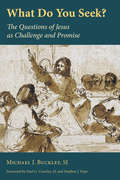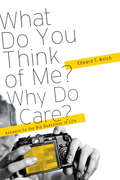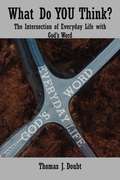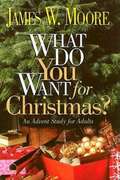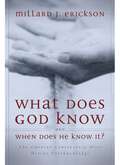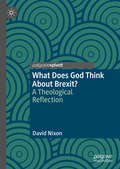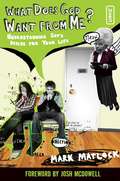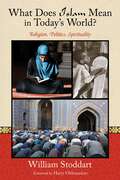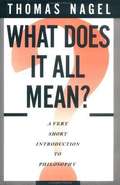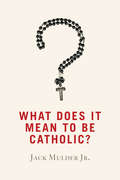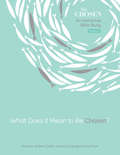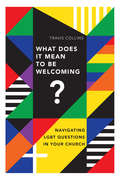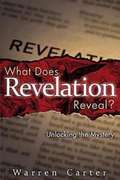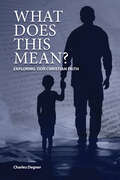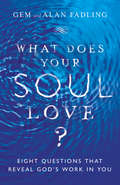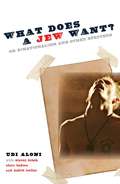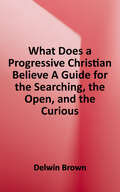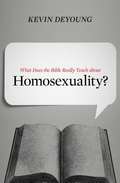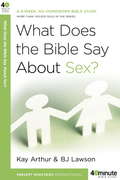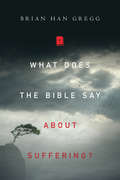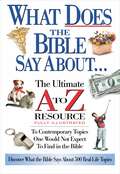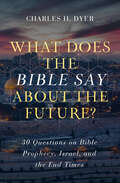- Table View
- List View
What Do You Seek?: The Questions of Jesus as Challenge and Promise
by Michael J. BuckleyThroughout the Gospels, Jesus asks a lot of questions—questions that challenge and unsettle. Questions that cut to the heart of human experience. Questions that—like a plow plunging deep into hard soil—split life open. In this book distinguished theologian Michael Buckley meditates on fourteen key personal questions that Jesus asks in the Gospel of John—such questions as "What do you seek?" "Do you know what I have done to you?" "How can you believe?" "Do you take offense at this?" "Do you love me?" Readers of Buckley's What Do You Seek? will be challenged anew by the searching, probing questions of Jesus.
What Do You Think of Me? Why Do I Care?: Answers to the Big Questions of Life
by Edward T. WelchTired of Trying to Win Approval and Escape Rejection?Peer pressure, codependency, shame, low self-esteem; these are just some of the words used to identify how people are controlled by others' opinions. Why is it so important to be liked? Why is rejection so traumatic?Edward T. Welch's insightful, biblical answers to these questions show that freedom from others' opinions and genuine, loving relationships grow as we learn about ourselves, others, and God. This interactive book includes questions for individual or group study and is suitable for teenagers and young adults.
What Do You Think?: The Intersection of Everyday Life with God’s Word
by Thomas DoubtWhat Do YOU Think? is a book by Thomas J. Doubt to stimulate thinking about aspects of everyday life that may not be on our front burners. Many people board a commercial airline each day; few, if any, might reflect on how the safety briefing might be used to tell someone about Jesus. A morning cup of coffee often allows us to ponder how our day might go, but does it draw our attention to warnings in the Bible? Riding a golf cart to the first tee probably does not inspire thoughts about our journey of faith.Jesus began several of his teaching moments by asking a simple question. What do you think? His intent was not to solicit personal opinions. The world is neck deep in personal opinions lacking a divine foundation. From the beginning, the Word that became flesh and dwelt among us wanted our brains to be engaged by his words so our thoughts might travel from mind to heart, and from heart to action. What Do YOU Think? is a book that follows the model of Jesus. Stories to stimulate thinking, scriptures to encourage the heart, and in the end, conviction to choose a better path.
What Do You Want for Christmas?: An Advent Study for Adults
by James W. Moore"What do you want for Christmas?" It's a question that gets asked often as the holiday season approaches and Christmas draws near. And if we're honest, much of the time when we think about how we would answer that question, we have material things on our mind. Author James W. Moore invites you to explore the question on a deeper level. Deep down, what do you really want for Christmas? Does your heart long for the gifts the Christ child brings--the type of gifts that money can't buy? This four-week study, appropriate for both group and individual use, provides an introduction and one lesson for each week of Advent. Each lesson includes a reference to a key passage of Scripture, a brief reflection, study / discussion questions, a brief prayer, and a focus for the coming week. JAMES W. MOORE, popular speaker and preacher, is the author over 40 books with Abingdon Press, with more than one million copies sold. He lives in Fairview, Texas.
What Does God Know and When Does He Know It?: The Current Controversy over Divine Foreknowledge
by Millard J. EricksonDoes God know the future? Or is the future unknowable to even God? Open theists believe the search for biblical answers will spark a new Revolution. Are they right? Arguing that God interacts with his creatures spontaneously, the controversial new movement known as “open theism” has called classic church theology up for reexamination. Confronting this view, classic theists maintain that God has complete foreknowledge and that open-theist arguments are unorthodox. Each view has implications for our vision of the future and of God’s dealings with humanity.
What Does God Think About Brexit?: A Theological Reflection
by David NixonThis book is a theological reflection about the process and event of Brexit: Britain’s departure from the European Union. Within a framework of liberation and postmodern theology, it examines Brexit against a history of the EU, with themes of community, identity, marriage, and divorce. It considers the emotional reactions which have been generated, and places Brexit in the context of contemporary populism and the politics of the United States. The book concludes with a call for reconciliation via new imaginaries of solidarity and inclusion.
What Does God Want from Me?
by Josh Mcdowell Mark MatlockMost teenagers think that being a Christian means doing the right thing. But figuring out what the “right thing” is can be a challenge. This book will guide your students through God’s Word and help them figure out what God really wants from them.
What Does Islam Mean in Today's World?: Religion, Politics, Spirituality
by William StoddartAlthough relatively unknown in the West, Islam has been forcefully brought to the public&’s attention by the acts and threats of the &“Islamic terrorists.&” As a result, the question is repeatedly asked: &“What kind of religion is this?&” Stoddart argues that in spite of appearances, Muslims are in fact allies with people of other faiths; they have common enemies and they are united in their opposition to all kinds of modern errors and immoralities, including materialism and secularism.
What Does It All Mean? A Very Short Introduction to Philosophy
by Thomas NagelOne philosopher's very short introductory account and critique of various philosophical problems.
What Does It Mean to Be Catholic?
by Jack MulderA clear, engaging introduction to the Catholic faith What does it mean to be Catholic? Many people, both non-Catholics and even Catholics themselves, really don't know. This accessible book by Jack Mulder is ideal for all who are curious to know more about Catholicism. Writing in a conversational style, Mulder clearly portrays the main contours of the Catholic faith. For readers who have ever wondered what exactly the Roman Catholic Church teaches about predestination, original sin, the Virgin Mary, abortion, same-sex marriage, and other issues, Mulder explains all that — and much more — in simple language. Mulder, who was raised in the Protestant tradition and converted to Catholicism later in life, speaks from the perspective of having wrestled with his own beliefs over the years. With solid information — and without proselytizing — Mulder's What Does It Mean to Be Catholic? presents a truly fresh perspective on the distinctive features of the Catholic faith.
What Does It Mean to Be Catholic?: A Guide For The Curious
by Jack Mulder Jr.A clear, engaging introduction to the Catholic faith What does it mean to be Catholic? Many people, both non-Catholics and even Catholics themselves, really don't know. This accessible book by Jack Mulder is ideal for all who are curious to know more about Catholicism. Writing in a conversational style, Mulder clearly portrays the main contours of the Catholic faith. For readers who have ever wondered what exactly the Roman Catholic Church teaches about predestination, original sin, the Virgin Mary, abortion, same-sex marriage, and other issues, Mulder explains all that — and much more — in simple language. Mulder, who was raised in the Protestant tradition and converted to Catholicism later in life, speaks from the perspective of having wrestled with his own beliefs over the years. With solid information — and without proselytizing — Mulder's What Does It Mean to Be Catholic? presents a truly fresh perspective on the distinctive features of the Catholic faith.
What Does It Mean to Be Chosen?: An Interactive Bible Study (The Chosen Bible Study Series #1)
by Amanda Jenkins Dallas Jenkins Dr. Douglas HuffmanThis is the official companion study to season 1 of The Chosen, the groundbreaking television series about the life of Jesus. What Does It Mean to Be Chosen? parallels each episode, connecting readers to the Bible in a brand-new way. It includes: A deeper look at Isaiah 43 and its fulfillment in Jesus and the lives of His followers (including us!)Script excerpts, quotes, and illustrations from the showGuiding questions for groups or individuals Being chosen by Jesus has beautiful and far-reaching implications—although it says even more about the Chooser than the choosees. We are loved because He&’s love. We are saved because He&’s merciful. We belong to the family of God because Jesus invites us, making the Bible and all its promises as true for us today as it was for God&’s chosen nation. What does it actually mean to be Chosen? To answer that question, we&’re going Old school—Testament that is—which leads us back to the New. Which always leads us directly to Jesus.
What Does It Mean to Be Welcoming?: Navigating LGBT Questions in Your Church
by Travis Collins16th Annual Outreach Magazine Resource of the Year - Social Issues/JusticeWhat Does It Mean to Be Welcoming?
What Does Revelation Reveal?: Unlocking the Mystery
by Warren CarterThe Book of Revelation has been mysterious, confusing, and misunderstood for centuries. Its content has been studied and analyzed by scholars from every corner of the globe. What is it about Revelation that draws us to it? Is this biblical book about end-time mysteries and hidden codes? Does and it relate to our present day?So what does Revelation actually reveal? Or should Revelation be left behind? According to Dr. Carter, the book of Revelation can tell us about biblical times as well as our own. It can show us how we, as Christians, are to live and hope for our world. Revelation reveals God's Word to God's World: that culture accommodation is dangerous, that judgment is taking place now, that the world does have a chance to repent, that there are evil powers working behind the scene, that the time is up for the eternal empire, and that God is coming in triumph.
What Does This Mean?: Exploring Our Christian Faith
by Charles DegnerHow do I teach God's Word to my children? For centuries, Luther's Small Catechism has been and continues to be a valuable tool for both pastors and parents in their spiritual teaching roles. What Does This Mean? Exploring Our Christian Faith is written especially for families with grade school children. This remarkable book will remind you that the catechism is not simply a textbook; it is a book that connects you to the message of life in the Bible by helping you discover and study biblical teachings in a planned way. You and your children will better understand what Baptism means for you, the blessings of the Lord's Supper, the meaning of the Lord's Prayer, the power and love of our heavenly Father, the redemption that is ours in his Son, the significance of the Holy Spirit's work, and much more. Featuring one devotion for each question in the catechism, this book will help prepare your children for catechism class and prepare believers of all ages for a life of faith!
What Does Your Soul Love?: Eight Questions That Reveal God's Work in You
by Alan Fadling Gem FadlingWhat do you really want? What is your soul clinging to? What is getting in your way?
What Does a Jew Want?: On Binationalism and Other Specters (Insurrections: Critical Studies in Religion, Politics, and Culture)
by Udi AloniIn the hopes of promoting justice, peace, and solidarity for and with the Palestinian people, Udi Aloni joins with Slavoj Zizek, Alain Badiou, and Judith Butler to confront the core issues of the Israeli-Palestinian conflict. Their bold question: Will a new generation of Israelis and Palestinians dare to walk together toward a joint Israel-Palestine? Through a collage of meditation, interview, diary, and essay, Aloni and his interlocutors present a personal, intellectual, and altogether provocative account rich with the insights of philosophy and critical theory. They ultimately foresee the emergence of a binational Israeli-Palestinian state, incorporating the work of Walter Benjamin, Edward Said, and Jewish theology to recast the conflict in secular theological terms.
What Does a Progressive Christian Believe?: A Guide for the Searching, the Open, and the Curious
by Delwin BrownA systematic understanding of progressive Christianity and the reasons for them. Progressive Christianity is a family of perspectives that vigorously rejects the "religious right" as a gross distortion of the Christian faith. Just as important, progressive Christianity criticizes and moves beyond the (other) conservatisms and the liberalisms of the immediate Christian past. This book presents one progressive Christian standpoint--introductory in character for ordinary people, not specialist.
What Does the Bible Really Teach about Homosexuality?
by Kevin DeyoungIn this timely book, award-winning author Kevin DeYoung challenges each of us—the skeptic and the seeker, the certain and the confused—to take a humble look at God’s Word regarding the issue of homosexuality.<P><P> After examining key biblical passages in both the Old and New Testaments and the Bible’s overarching teaching regarding sexuality, DeYoung responds to popular objections raised by Christians and non-Christians alike, making this an indispensable resource for thinking through one of the most pressing issues of our day.
What Does the Bible Really Teach?
by Watch Tower Bible and Tract Society of New York Inc.From the Book READ any newspaper. Look at television, or listen to the radio. There are so many stories of crime, war, and terrorism! Think about your own troubles. Perhaps illness or the death of a loved one is causing you great distress. You may feel like the good man Job, who said that he was "drenched with misery."-Job 10:15, The Holy Bible in the Language of Today. Ask yourself: Is this what God purposed for me and for the rest of mankind? Where can I find help to cope with my problems? Is there any hope that we will ever see peace on the earth? The Bible provides satisfying answers to these questions. Do not quickly dismiss what is presented on the preceding pages as mere wishful thinking. God has promised to bring these things about, and the Bible explains how he will do so. But the Bible does more than that. It provides the key to your enjoying a truly satisfying life even now. Think for a moment about your own anxieties and troubles. They may include money matters, family problems, loss of health, or the death of a loved one. The Bible can help you to deal with problems today, and it can provide relief by answering such questions as these: Why do we suffer? How can we cope with life's anxieties? How can we make our family life happier? What happens to us when we die? Will we ever see our dead loved ones again? How can we be sure that God will fulfill his promises for the future? The fact that you are reading this book shows that you would like to find out what the Bible teaches. This book will help you. Notice that the paragraphs have corresponding questions at the bottom of the page. Millions have enjoyed using the question-and-answer method when discussing the Bible with Jehovah's Witnesses. We hope you will too. May you have God's blessing as you now enjoy the thrilling and satisfying experience of learning what the Bible really teaches!
What Does the Bible Say About Sex? (40-Minute Bible Studies)
by Kay Arthur David Lawson B. J. LawsonDoes God really care about your sex life? In a culture saturated with sex, many find it hard to believe the Creator of the universe cares about this facet of their lives. Others are confused about where to draw the line to avoid going "too far." Married or single, you need to know what God says about sex. After all, He's the one who designed this priceless gift and set clear boundaries to protect it. This candid study will help you weigh the messages of our culture against the truth of God's Word. As you learn about the Designer's original intent for sex, you'll gain valuable insights to guide your daily choices.
What Does the Bible Say About Suffering?
by Brian Han GreggWhat Does the Bible Say About Suffering?
What Does the Bible Say About...: The Ultimate A To Z Resource (A to Z Series)
by Thomas NelsonHave you ever wondered: what does the Bible have to say about___? Now you fill in the blank. This Ultimate A to Z Resource applies biblical insight to hundreds of contemporary topics ranging from:AddictionPolitical infightingWorld hungerBirth controlFreewillDysfunctional familiesPrejudiceand Natural disastersIn this handy, portable index, you can easily locate any topic—from the broad (conflict resolution, anxiety, and companionship), to the very specific (contracts, debt, and pornography). Each entry contains a summary of the topic, theological/biblical considerations, and verse references to point you directly to the larger scriptural context.The Bible may be 2,000 years old, but it has relevant and wise words on just about any subject, ancient or modern—it is the Living Word of God, and this quick guide is one great way to familiarize yourself with its contents...one topic at a time.Also contains illustrations from Christian cartoonist Jonny Hawkins.
What Does the Bible Say about the Future?: 30 Questions on Bible Prophecy, Israel, and the End Times
by Charles H. DyerAnyone can make predictions about the future. The real question is, &“What does God have to say about it?&”The end times is one of those areas of theology where people have many wild opinions. Don&’t get caught up in all the internet speculations and doomsday prognostications. The real place to find out about the future is the Word of God.In What Does the Bible Say About the Future?, radio host and prophecy expert Dr. Charlie Dyer offers you an insightful look at the end times that&’s grounded not in human fantasies but in the very revelation of God. The Bible actually does have a lot to say about the future. It&’s an important topic for you to study. So instead of taking your cues from the self-appointed prophets of today, let Dr. Dyer take you right back to Scripture. You&’ll get answers to questions like:Are we in the last days right now?Are pandemics like Covid-19 a fulfillment of Bible prophecy?What is the Battle of Armageddon?What is the next event on God&’s prophetic calendar?Where is the United States in Bible prophecy?And most importantly . . . If prophecy is true, what difference should it make in my life?God didn&’t give us Bible prophecy to tickle our imagination or satisfy our intellectual curiosity. Rather, God wants us to know about the end times so we can be confident in His eternal purposes. With a biblical understanding of the future, you&’ll be powerfully equipped to live with faith and hope today!
What Does the Bible Say about the Future?: 30 Questions on Bible Prophecy, Israel, and the End Times
by Charles H. DyerAnyone can make predictions about the future. The real question is, &“What does God have to say about it?&”The end times is one of those areas of theology where people have many wild opinions. Don&’t get caught up in all the internet speculations and doomsday prognostications. The real place to find out about the future is the Word of God.In What Does the Bible Say About the Future?, radio host and prophecy expert Dr. Charlie Dyer offers you an insightful look at the end times that&’s grounded not in human fantasies but in the very revelation of God. The Bible actually does have a lot to say about the future. It&’s an important topic for you to study. So instead of taking your cues from the self-appointed prophets of today, let Dr. Dyer take you right back to Scripture. You&’ll get answers to questions like:Are we in the last days right now?Are pandemics like Covid-19 a fulfillment of Bible prophecy?What is the Battle of Armageddon?What is the next event on God&’s prophetic calendar?Where is the United States in Bible prophecy?And most importantly . . . If prophecy is true, what difference should it make in my life?God didn&’t give us Bible prophecy to tickle our imagination or satisfy our intellectual curiosity. Rather, God wants us to know about the end times so we can be confident in His eternal purposes. With a biblical understanding of the future, you&’ll be powerfully equipped to live with faith and hope today!
